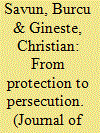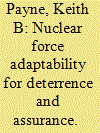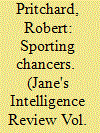| Srl | Item |
| 1 |
ID:
164557


|
|
|
|
|
| Summary/Abstract |
The security consequences associated with refugee flows are among the most widely studied aspects of forced migration. While the majority of this research program has focused on how refugee movements affect the risk of political violence, scant scholarly attention has been paid to violence perpetrated against refugees. Building upon the state repression literature, we argue that refugees are particularly vulnerable to the violation of their physical integrity rights in the wake of terrorist attacks in host states. Governments are pressured to respond to security crises but prefer to take actions without jeopardizing public support. In this context, refugee groups can be strategically attractive targets of repression because they lack electoral power and citizens are often supportive of government crackdown against foreigners in times of security crises. Given that leaders have stronger incentives to respond to voters’ demands quickly in democracies, we expect the effect of terror attacks on violence against refugees to be stronger in democratic host states. Using a novel global dataset on anti-refugee violence between 1996 and 2015, we show that refugees are more likely to be exposed to violence by the coercive agents of the state in the wake of security crises. We provide suggestive evidence that the repression of refugees is more consistent with a scapegoating mechanism than the actual ties and involvement of refugees in terrorism. The findings reveal that the well-being of uprooted populations is particularly at risk when host countries face a security threat.
|
|
|
|
|
|
|
|
|
|
|
|
|
|
|
|
| 2 |
ID:
140727


|
|
|
|
|
| Summary/Abstract |
This monograph, Nuclear Force Adaptability for Deterrence and Assurance: A Prudent Alternative to Minimum Deterrence, is the second in a series examining the U.S. goals of deterrence, extended deterrence and the assurance of allies, and how to think about the corresponding U.S. standards of adequacy for measuring “how much is enough?” It begins by examining the manifest character of the contemporary threat environment in which the United States must pursue its strategic goals of deterring foes and assuring allies. Fortunately, there is considerable available evidence regarding the character of the contemporary threat environment and its general directions. Noted historians have compared this threat environment not to the bipolar Cold War, but to the highly dynamic threat environments leading to World War I and World War II. The uncertainties involved are daunting given the great diversity of hostile and potentially hostile states and non-state actors, leaderships, goals, perceptions, and forces that could be involved.
|
|
|
|
|
|
|
|
|
|
|
|
|
|
|
|
| 3 |
ID:
129600


|
|
|